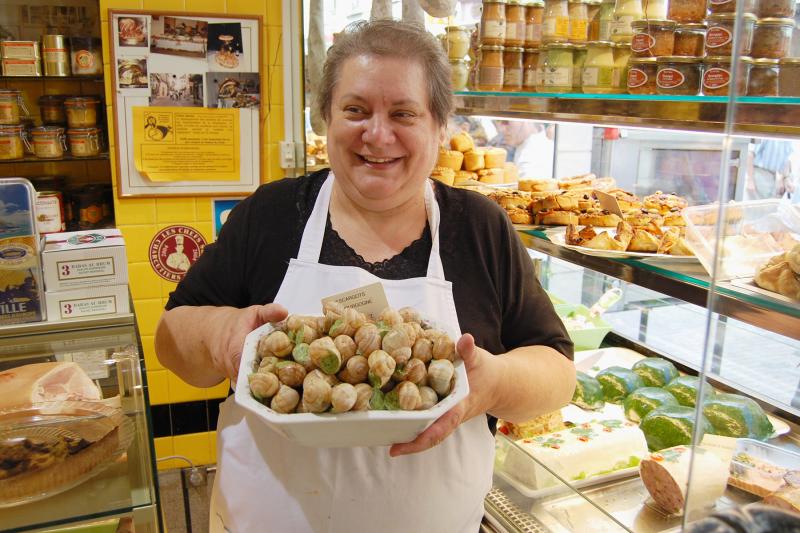Rick Steves’ Europe: Escargot and the beauty of Terroir
Appears in the Online Edition, May 2021.
As we’ve had to postpone our travels because of the pandemic, I believe a weekly dose of travel dreaming can be good medicine. Here’s one of my favorite European memories from France — a reminder of the fun that awaits us at the other end of this crisis.
Walking through France’s finest vineyards in the fabled Côte d’Or (“Gold Coast”) of Burgundy, the proud vintner guiding me becomes evangelical.
Pointing to the ground, she says, “A good grape must suffer. Look at this soil — it is horrible ... it is only rocks. That is why these grapes have character. The roots of these struggling vines are thin as hairs. Searching as much as 30 meters down, they reach, reach, reach for moisture. The vines in the flat fields” — she motions, almost disdainfully, to fields just a kilometer away — “have it too easy ... a silver spoon in their mouths. It’s like people. Paris Hilton, she is not interesting. The fine wines of humanity, they are the ones who have suffered.”
“Like Tina Turner?” I ask.
“Exactly!” she says.
“The best vintners don’t force their style on the grape. They play to the wine’s strength, respecting the natural character of the sun, soil, and vine ... the terroir. They play the wine like a great musician plays classical music. You don’t want to recognize the musician. You want to hear the Beethoven.”
That afternoon, I bike through these revered vineyards, where road signs read like a list of fine wines. Wines here are named not for the grape, but for the place of their origin. The more specific the place name, the higher the quality. A wine called simply “Burgundy” for the region would be a basic table wine. A wine labeled by the village (for instance, “Pommard”) would be better. Those named for the vineyard (such as “Clos de Pommard”) would be excellent, and for a certain patch of land within that vineyard (cru or grand cru) the very best.
I head to a restaurant set in a vineyard that I remember from a previous visit, a place called Le Relais de la Diligence. Two years ago, the vines were lapping at its tables. Today, it’s in a wheat field. I’m told that with the whole world making good wines, the French are cutting back on quantity, using marginal land for other crops, and working to build the quality.
Despite the view of wheat instead of grape vines, the food is delightful, as is the wine. I’m struck by the sophistication of the presentation and service as well as the casual atmosphere, with families and even dogs enjoying the scene. (There is a doggy meal printed on the menu.)
Feeling adventurous, I order the escargot, a classic French dish that’s sourced a little differently these days. Good escargot must grow wild. The great French snail was once so common that early-19th-century train companies hired women and children to clean them off the tracks so the trains could get a grip. Today, the French snail has gone the way of the great American buffalo. As effective chemicals have successfully killed off weeds and undesirable insects, they have also decimated the slug and snail populations. Much of the escargot in France is farmed. Locals know the farmed gray snails are mediocre at best. The top-quality, free-range snails most likely last slithered in Poland.
Through my meal, I ponder, not for the first time, whether there is something pseudo-sophisticated about all this finicky French food culture. While buying wine, if you ask what would be good with escargot, the wine merchant will need to know how you plan to cook the snails. “Oh, you’re cooking it that way? Then you need something flinty — a Chablis.” Too bad if you were hoping for a good chardonnay.
Then I think of the way an American who pooh-poohs the French passion for fine points in cuisine might celebrate the nuances of baseball. Take a Frenchman to the ballpark. All the stuff that matters to me — how far the runner is leading off first base, who’s on deck and how he does against lefthanded pitchers, how deep the bullpen is, put in a pinch runner! — is nonsense to him.
The next time I put a little ketchup on my meat and my French friend is aghast, I’ll accept it with no judgment. I’ll just remember that with two outs and a full count, he’ll have no idea how I know the runner’s off with the pitch.
(Rick Steves (www.ricksteves.com) writes European guidebooks, hosts travel shows on public TV and radio, and organizes European tours. This article was adapted from his new book, For the Love of Europe. You can email Rick at rick@ricksteves.com and follow his blog on Facebook.)

